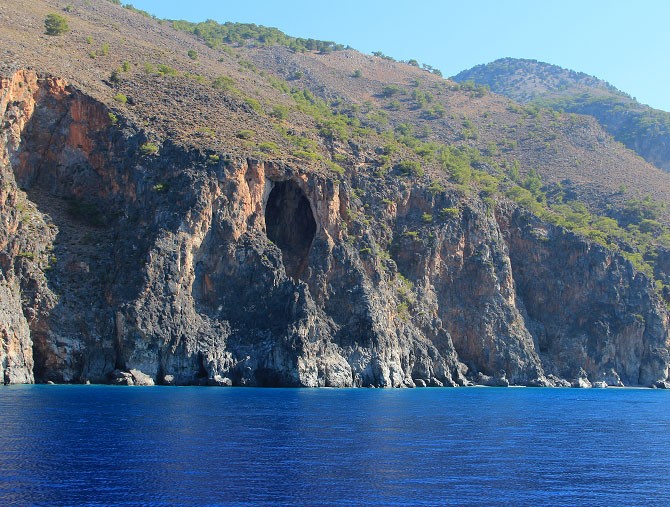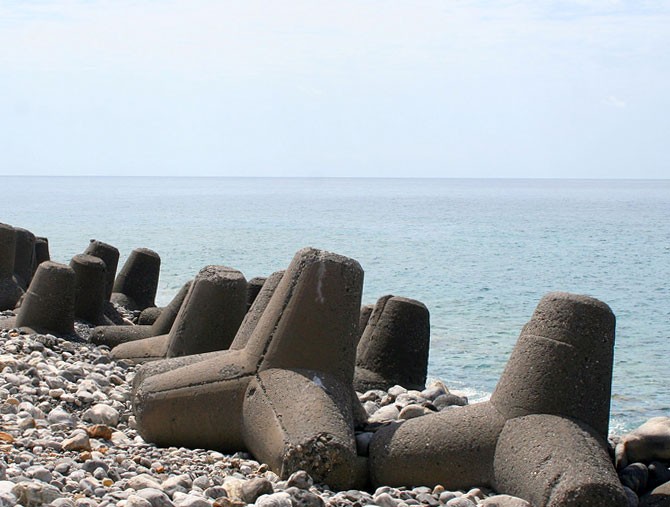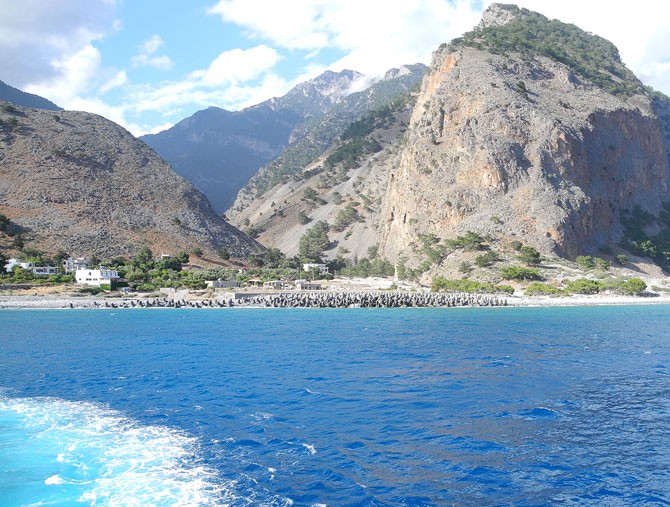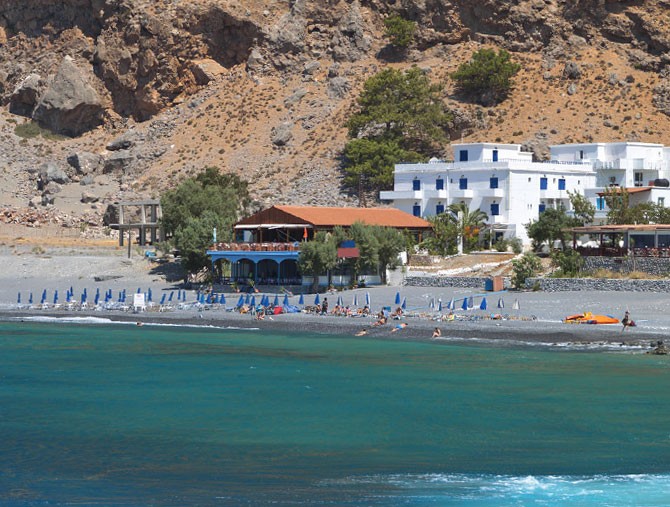Агия Румели
История этого места довольно интересна. Считается, что деревня была построена на месте, где в V веке до н. э. находился город Тарра. Небольшой, однако автономный и широко известный, чеканивший свою монету. Своего расцвета город достиг во времена Римской империи. К востоку от русла реки, в области Азоиромури, были проведены археологические раскопки, в ходе которых найдены сосуды и скульптуры эпохи эллинизма, украшения IV века до н.э. и предметы римского периода. Считается что именно Тарра была местом, где Аполлон и Артемида скрывались после убийства дракона Пифона в Дельфах. Вполне логично, что в древности тут был храм Аполлона. Останки этого храма можно увидеть в Самарийском ущелье. На останках храма Артемиды в самой деревне был построен византийский храм Божей Матери XV века. По утверждением археологов, в заливе Агия Румели раньше находился древний порт, а на морском дне можно найти останки разбившихся кораблей. Однако, на сегодняшний момент ни один из них не был найден. В любом случае, купаясь на пляжах этого места определенно стоит попытать счастья.
Во времена турецкого ига в Агия Румели находились центральные военные склады повстанцев. В 1866 году три турецких военных корабля подвергли деревню бомбардировке в результате которой погибли женщины и дети ожидавшие эвакуации. В июле 1867 года Омер Паша высадился здесь с 4 тысячным войском и сжёг деревню, однако не смог проникнуть в ущелье где укрепились греки.
После окончательного подавления восстания в 1887 году, турки построили в деревне различные укрепления. Руины форта, который служил для контроля выхода из ущелья Самария, видны на двухсотметровом хребте с северной стороны Агия Румели.
Существует мнение, что туристы останавливаются в Агия Румели исключительно для того, что бы попасть в Самарийское ущелье, однако это не совсем верно. В деревне имеется несколько гостиниц и ресторанов и многие остаются здесь на несколько дней. Это практически идеальное место для спокойного отдыха. Местный галечный пляж Агиос Павлос, где Святой Павел крестил христианан (по легенде), так же хорош как и другие пляжи на западе от деревни. По воде из Агия Румели можно отправится к другим прекрасным пляжам: Мармара, Лутро, Глика Нера, Трипити и Домата.
Как добраться до Агия Румели:
- на пароме из Хоры Сфакион, Сугии и Палеохоры порядка 4-5 ежедневных рейсов. Зимой сообщение ограничен.
Tекст: Александр Фролов
Agia Roumeli
After a tiresome 6-7 hours hiking in the outstanding Samaria Gorge, your steps will lead you to the Agia Roumeli: a beautiful seaside Cretan village, washed by the Libyan Sea. Apart from its beauty, the village has also a great history.
In the antiquity, at the site of the current village, at the east bank of the river Samaria, there was a very known ancient city. Its name was Tarra. It is believed that the ancient city Taras in Magna Graecia in Italy was Tarra’s colony. Anyway, the legend has it that in Tarra was where Apollo and Artemis had fled for atonement after the murder of Python in Delphi. Just for the record, Python was a dragon that was worshiped in Delphi before Apollo. In Tarra, Apollo fall in love with the nymph Akakallida and their sons were Filakis and Filandros, the founders of the Ancient Elyros. It is needless to say that Tarra became a great center of Apollo’s worship, and was adorned by a magnificent temple dedicated to the god. Today, the ruins of the temple are located at the exit of the Samaria Gorge, while there was also another temple dedicated both to Apollo and Artemis at the east of the current village. The wonderful mosaic floor of this temple can be
seen in the yard of the today’s Church of Assumption which was built at this place. In Tarra there was also the only glassblazery of the Ancient Crete. The city was continuously inhabited from the Early Archaic period to the Roman period and was important enough to have its own currency. The archaeological site is constantly visited.
The archaeologists also believe that the bay of the Agia Roumeli was an ancient port and that perhaps there are ancient shipwrecks under the sea waters, but none of them has been located yet. (Is there any volunteer diver to do the dirty job?).
There are two versions on how the Agia Roumeli took its name. The first one says that probably in the Roman times there was an ancient temple in the area, dedicated to the Roman goddess Roumilia. After the spread of Christianity in Crete, this temple was turned into a Christian church dedicated to Agia Roumilia (or something like that) and with the passage of the years, the name changed to Agia Roumeli and named the whole area. The other version says that the name Agia Roumeli comes from the Arabic words «aia» (water) and «rumeli» (Greek), meaning “Greek water”. Oh, well...
Since 1954, the Agia Roumeli was located in a different place, about 1 kilometer from the beach, shortly after the exit of the Samaria Gorge. However, heavy rains made the river of the gorge to overflow, causing major damage to the village, which moved to its current seaside location.
What you should also know about the Agia Roumeli is that (like Loutro) is accessible only by boat (and on foot, via the Samaria Gorge). Surrounded by the imposing Lefka Ori (White Mountains) this beautiful, picturesque village seems absolutely banned, like a well hidden secret you can reveal only if you make a great effort (but it definitely deserves it).
The truth is that usually the Agia Roumeli is being used as a short stop of the hikers who just crossed the Samaria Gorge. However, there are accommodations in the village for the people who would love to spend a few days in a beautiful, peaceful place. So, either you have a few hours to spend before you take the boat or you decided to stay for a few days in the Agia Roumeli, apart from the ruins of the Ancient Tarra, other highlights of the village that you could visit is the Byzantine church in the beach of Agios Pavlos, where it is believed that the Apostle Paul baptized the Christians, and the two Turkish castles over the Agia Roumeli, from where the view is breathtaking.
As for the beaches, you can choose between the beach of Agios Pavlos to the east or the beach with the pebbles to the west. If you are bored easily, then you can take a boat and sail to the other beautiful beaches of the area (Marmara, Loutro and Glyka Nera to the east, Trypiti and Domata to the west). The boat will be your best friend in this place anyway.
How to get there: By boat from Chora Sfakion, Sougia or Palaiochora. In the winter, the itineraries are limited, but between May and October, when the Samaria Gorge is open to visits, there are about 4-5 daily itineraries from the Chora Sfakion to the Agia Roumeli and one from Palaiochora and Loutro -and back. On foot via the Samaria Gorge.
Τext: Marilou Pantazi






